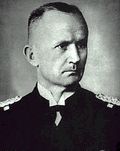Karl Dönitz joined the German submarine fleet in December 1916 after serving as navy lieutenant during World War I. He was captured by the British forces and returned to Germany in 1920. Dönitz continued his career as navy officer and became the captain of the Emden cruiser in 1934. Supporting the idea of creating the German submarine fleet, Dönitz supervised this program and was appointed the fleet commander in 1936. The submarine war against the allied convoys in Northern Atlantic, directed by Dönitz, almost led to interruption of British supplies to the allies. Dönitz was elevated to the rank of admiral in March 1942. In January 1943, he replaced admiral Erich Raeder as commander in chief of the German Navy with the rank of Großadmiral. On 20 Apr 1945, Adolf Hitler appointed Admiral Dönitz head of the northern military and civil command. In Hitler's political testament written on 29 Apr 1945, the Führer made Dönitz Reich President reserving the office of Reich Chancellor for Joseph Goebbels. Dönitz assumed the office on 1 May 1945 and appealed for continuation of war in the east. He established his headquarters in Flensburg, Schleswig-Holstein, from where he directed the activities of German armies and authorized the signing of the capitulation at Reims on 7 May 1945. The British forces arrested the Reich government including Dönitz on 23 May 1945. The Nürnberg International Military Tribunal sentenced Dönitz to 10 years' imprisonment (1 Oct 1946). He was released from the Berlin-Spandau prison in 1956. Biography source: [2] |

